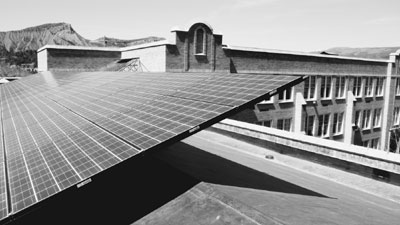|
| ||
| Sunny disposition
by Will Sands The electric meters are now spinning backwards at Durango’s Smiley Building. The community arts center celebrated a major milestone last month. Thanks to a combination of conservation efforts and several major solar panel installations, the building is now producing all of its own electricity. Now, the “green collar workers” behind the achievement are hoping to spread the message through Durango and beyond. Located in the 1300 block of East Third Avenue, the 45,000-square-foot Smiley Building was built in 1936 as a junior high school. However, six decades later, it had been abandoned and widely regarded as a community eyesore. In 1997, three partners – Charles and John Shaw and Lisa Bodwalk – had the vision to resurrect the building as a community arts center. Shortly after opening the doors, $5,000 utility bills arriving in the mail, and the expense of operating a giant, dated structure became apparent to the three. “We really didn’t have any particular vision from an energy standpoint at the beginning,” said Charles Shaw. “We really just wanted to do as much conservation as possible to make running this place affordable. But it’s definitely evolved from there.” In addition to serving as a community arts center, the Smiley Building is also serving as a demonstration of what can be done to “green” a large structure. The historic building has been brought into the 21st century with endless efficiency innovations – high-efficiency boilers, motion-detected lighting, thousands of compact fluorescent light bulbs, low-flow faucets, waterless urinals, solar heating and on-demand water heaters to name a few. In March, the Smiley Building also capped off a major solar panel installation, complementing efficiency measures with power generation. Joining an existing array of 72 panels, 120 new panels were installed, now fully powering the building and even spinning electricity back into the grid during sunny days. Smiley is now the only building of its size and type in America that is creating all of its own electricity, according to Shaw. “We’re basically making at least the amount of electricity we use,” Shaw explained. “In the day, we make excess, send it back into the power grid and use it at night.” As an added plus, Xcel Energy is buying back “Renewable Energy Credits” from Smiley, which translated into a $1,400 check last month. Tom Bartels, who is working with Shaw on the energy project, noted that the solar panels are flashy and exciting but the efficiency of the building was the key step. “The first step is always efficiency and conservation,” he said. “Then you can add that savings to pay for part of your solar setup. We started with a very light footprint, and that’s the only reason this works.” Though the days of four-figure, monthly utility bills are in the distant past, the building does still use natural gas to the tune of approximately $400 per month. The ultimate goal is to have a building completely independent of fossil fuels. “This is a working facility that happens to pay attention to how it uses its energy,” Bartels said. “Our ultimate goal is to have the building full, vibrant and widely used without relying on any fossil fuels.” Another goal is spreading the message that energy efficiency is available and attainable in the Durango area. “One of the key components is that Smiley is only one experiment in this community,” Bartels said. “Underlying all of this is the need for all of us to wake up to the realities of energy in all of its forms. We’re all users, and there are a variety of ways we can change our behavior.” Shaw puts the total cost of the Smiley Building’s solar array at “right around four new SUVs without many options” or approximately $200,000. At first glance, the sum may seem steep, but Shaw argues otherwise. “You could say it seems prohibitive, but look at our town and what people are spending their money on,” he said. “There are plenty of people here with the means for doing this. It’s just a matter of priorities. No on ever questions dropping $50,000 on a new car.” In addition, the Smiley Building’s investment is paying back rich rewards. In addition to the Xcel Energy rebate, Shaw estimates that his electricity bill has been paid in full for the next 30 years. “In these kinds of buildings, energy conservation is a money maker, and making these kinds of changes is a good investment,” he said. “Basically, we’ve bought 25 to 30 years of electricity, and we have a fixed cost for that. We are also insulated from any increases in prices.” The savings are also available at the most basic levels, according to Shaw, it’s just a matter of taking the step. “Conservation and alternative energy are accessible to everyone at some level and everyone should be involved,” he said. “Compact fluorescent light bulbs cost $1.50 at some stores. You can get started for less than a cup of coffee. The problems have already been solved. You’ve just got to do it.” And the pay offs are much more than financial for the Smiley Building and others who make efficiency a priority. “It’s nice to know we’re using cleaner power than the year before, less coal smoke is going into the atmosphere and the global picture is improving because of our actions,” Bartels said. “It’s nice to turn on the switch and know where that energy is coming from.” •
|


